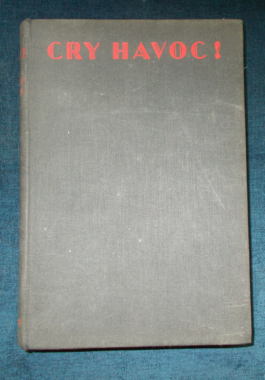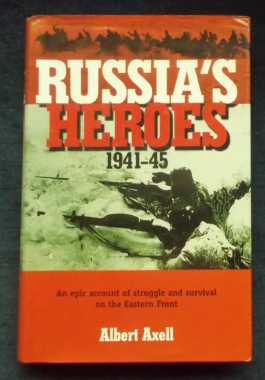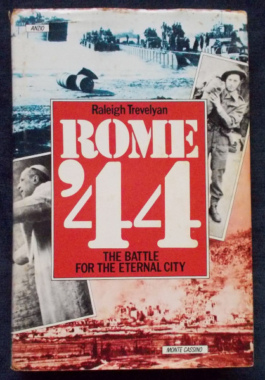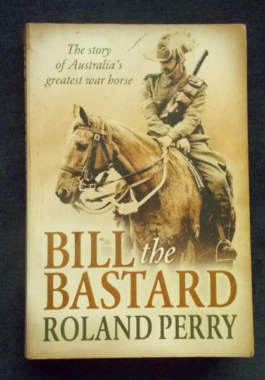-

Cry Havoc! Beverley Nichols
$45.00Written in 1933, this book caused furor in many quarters. It's a far cry from Nichols' usual light-hearted badinage, being a bitter denunciation of the world's attitude toward peace and war and a thorough research into the activities of offensive preparations going on in the armament factories in England and on the Continent. It also covers the ineffectual preparations being made for defensive measures. Faced with the fact that war was brewing, the League of Nations was rendered virtually impotent through the media of the day and public opinion and that the civilian population is certain to be the victim in the next European War, his findings are far from negligible. The last half of the book is a succession of challenging dialogues, in which socialism, capitalism, militarism and pacifism are all given ardent advocates. Time and events demonstrated that Nichols predicted how World War II would proceed with uncanny 99% accuracy. -

Australia was almost defenceless against Japanese attack in 1942. Here it is suggested that vital lessons for today can be learnt from that period. Did the Australian leaders rely too heavily on Britain and were they let down? How much can Australia rely on any country for support in wartime? From the days of the First Fleet it was always accepted that the United Kingdom would send its fleet to defend Australia. For this reason Australia sent troops overseas as early as 1885 to help fight Imperial wars. The situation changed after 1918 for then Japan became a likely enemy. Could Britain defend Australia from attack and conduct a war in Europe? Dr. McCarthy examines both sides of the question and concludes that it was never possible.
-
 For four years in World War II, out of an unquestioned love for their mother country, the Russian people heroically defended their soil with their blood. Here is the full story of the valor of the sons and daughters, soldiers and villagers, Cossacks and snipers who battled in Moscow and Stalingrad, in the Caucasus and the Arctic, at the Brest fortress and Kursk Bulge. From the account of the aging Russian general who suffered drenchings in ice-cold water rather than collaborate with his Nazi captors to that of the nineteen-year-old private who flung himself on the gun port of a German pillbox so that his comrades could advance, these pages not only chronicle extraordinary selfless acts of heroism but also rectify an astonishing oversight in innumerable histories of World War II. With 16 pages of black-and-white photographs.
For four years in World War II, out of an unquestioned love for their mother country, the Russian people heroically defended their soil with their blood. Here is the full story of the valor of the sons and daughters, soldiers and villagers, Cossacks and snipers who battled in Moscow and Stalingrad, in the Caucasus and the Arctic, at the Brest fortress and Kursk Bulge. From the account of the aging Russian general who suffered drenchings in ice-cold water rather than collaborate with his Nazi captors to that of the nineteen-year-old private who flung himself on the gun port of a German pillbox so that his comrades could advance, these pages not only chronicle extraordinary selfless acts of heroism but also rectify an astonishing oversight in innumerable histories of World War II. With 16 pages of black-and-white photographs. -
 When the author, a wounded veteran of 21, arrived in Rome in 1944, the question most Italians asked him was: 'What took you so long?' What indeed? Were the Allied High Command to blame? Were the generals incompetent? Was the Anzio landing itself a tactical error? In 1956 Raleigh Trevelyan published, as The Fortress, the diaries he had surreptitiously kept in the Anzio trenches and, as a result, made contact with a number of Germans who had been only yards away from him twelve years earlier. Now that statesmen and generals have published their memoirs and official histories of the war have been written, it seems possible at long last to attempt an answer. This is a remarkable book, bringing together the skill and insight of an accomplished historian, the narrative drive of a gifted storyteller, and the rage and terror of a man experiencing at first hand the momentous events from Anzio to Monte Cassino and on to Rome. The reader follows the fate of the 'poor bloody infantry' on both sides of the line; sees a group of Romans adapting to the idea that the Germans are still there; penetrates the secrets of the Vatican; watches the Allied and German generals on the spot fight with their High Commands and hears what Hitler, Churchill, Roosevelt and Stalin thought about it at the time. Illustrated with black and white photographs and even some contemporary cartoons.
When the author, a wounded veteran of 21, arrived in Rome in 1944, the question most Italians asked him was: 'What took you so long?' What indeed? Were the Allied High Command to blame? Were the generals incompetent? Was the Anzio landing itself a tactical error? In 1956 Raleigh Trevelyan published, as The Fortress, the diaries he had surreptitiously kept in the Anzio trenches and, as a result, made contact with a number of Germans who had been only yards away from him twelve years earlier. Now that statesmen and generals have published their memoirs and official histories of the war have been written, it seems possible at long last to attempt an answer. This is a remarkable book, bringing together the skill and insight of an accomplished historian, the narrative drive of a gifted storyteller, and the rage and terror of a man experiencing at first hand the momentous events from Anzio to Monte Cassino and on to Rome. The reader follows the fate of the 'poor bloody infantry' on both sides of the line; sees a group of Romans adapting to the idea that the Germans are still there; penetrates the secrets of the Vatican; watches the Allied and German generals on the spot fight with their High Commands and hears what Hitler, Churchill, Roosevelt and Stalin thought about it at the time. Illustrated with black and white photographs and even some contemporary cartoons. -
 More and more Australians are reflecting on the soldiers who helped shape our nation. Many are choosing to make pilgrimages to the battlefields of our history, to bring to life names like the Somme, Passchendaele and Ypres. This is the essential companion for anyone visiting the Western Front, presenting well-illustrated walking tours across fourteen of the most important battlefields on easily accessible walking routes, it points out to readers the battlefield landmarks that still exist - the memorials to the men who fought there and the cemeteries where many of them still lie. There are moving quotes and black and white illustrations revealing the experiences of war from the common Aussie digger together with easy-to-follow- directions that allows anyone to visit the battlefields and walk in the footsteps of the first ANZACS.
More and more Australians are reflecting on the soldiers who helped shape our nation. Many are choosing to make pilgrimages to the battlefields of our history, to bring to life names like the Somme, Passchendaele and Ypres. This is the essential companion for anyone visiting the Western Front, presenting well-illustrated walking tours across fourteen of the most important battlefields on easily accessible walking routes, it points out to readers the battlefield landmarks that still exist - the memorials to the men who fought there and the cemeteries where many of them still lie. There are moving quotes and black and white illustrations revealing the experiences of war from the common Aussie digger together with easy-to-follow- directions that allows anyone to visit the battlefields and walk in the footsteps of the first ANZACS. -
 In the darkest days of World War II, this is the true story of ten brave young men flying their twenty-fifth and final bombing mission in the Flying Fortress, Memphis Belle. Some say the team is exceptional; others that the Memphis Belle is the luckiest plane in the war. But this is a mission that can change everything. Only if the men can successfully destroy the munitions factory in the heart of Germany will they get to go home. Dangerous, almost impossible, it is a mission that will test their skill and teamwork to the limit - and each man will become a hero - whether he lives or dies. Monte Merrick also wrote the screenplay for the Warner Bros film of the same name.
In the darkest days of World War II, this is the true story of ten brave young men flying their twenty-fifth and final bombing mission in the Flying Fortress, Memphis Belle. Some say the team is exceptional; others that the Memphis Belle is the luckiest plane in the war. But this is a mission that can change everything. Only if the men can successfully destroy the munitions factory in the heart of Germany will they get to go home. Dangerous, almost impossible, it is a mission that will test their skill and teamwork to the limit - and each man will become a hero - whether he lives or dies. Monte Merrick also wrote the screenplay for the Warner Bros film of the same name. -
 Bill was massive. He had power, intelligence and unmatched courage. In performance and character, he stood above all the other 200,000 Australian horses sent to the Middle East in the Great War. But as war horses go, he had one serious problem. No one could ride him but one man, Major Michael Shanahan. Some even thought Bill took a sneering pleasure in watching would-be riders hit the dust. This is a remarkable tale of a bond between a determined trooper and his stoic but cantankerous mount. They fought together. They depended on each other for survival. And when the chips were down, Bill's heroic efforts and exceptional instincts in battle saved the lives of Shanahan and four of his men. By September 1918, 'Bill the Bastard' was known by the entire Light Horse regiment, who used his name not as an insult, but as a term of endearment. Bill had become a legend, a symbol of the courage and unbreakable will of the Anzac mounted force. There was no other horse like Bill the Bastard.
Bill was massive. He had power, intelligence and unmatched courage. In performance and character, he stood above all the other 200,000 Australian horses sent to the Middle East in the Great War. But as war horses go, he had one serious problem. No one could ride him but one man, Major Michael Shanahan. Some even thought Bill took a sneering pleasure in watching would-be riders hit the dust. This is a remarkable tale of a bond between a determined trooper and his stoic but cantankerous mount. They fought together. They depended on each other for survival. And when the chips were down, Bill's heroic efforts and exceptional instincts in battle saved the lives of Shanahan and four of his men. By September 1918, 'Bill the Bastard' was known by the entire Light Horse regiment, who used his name not as an insult, but as a term of endearment. Bill had become a legend, a symbol of the courage and unbreakable will of the Anzac mounted force. There was no other horse like Bill the Bastard.






